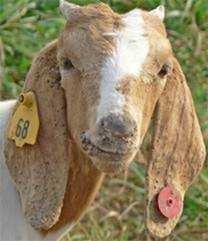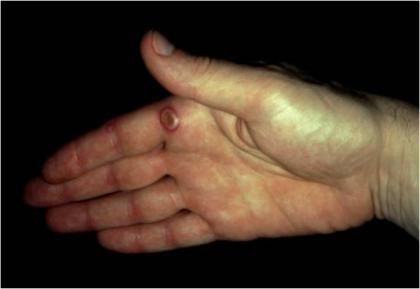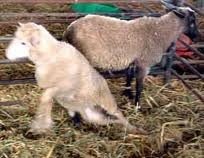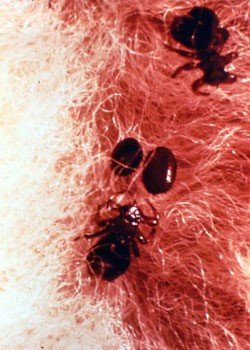Orf
Other names: Sore mouth, Contagious pustular dermatitis, Ecthyma, Mbururor Humbururu (Borana & Gabbra); Lopedo or Non-kutukie (Samburu); Ambarrur, Mburur (Somali); Ngiborwok, Mburuwok (Turkana)
Description: A very common infection that affects especially young lambs and kids and occurs worldwide. It produces lesions on the lips and is often more severe in goats than in sheep. - Occasionally the virus can also infect humans who handle infected animals. In humans it causes a localised round skin lesion, mostly on the hands, which is painful but heals without treatment. Wearing gloves when working with infected sheep will protect you against Orf.
Cause: Orf is caused by a virus that can be found wherever sheep and goats are kept. There is no specific treatment against Orf.
Signs of Orf:
Small pustules appear first on the junction between upper and lower lip (in the corner of the mouth). The pustules later rupture and produce dry scabs, looking similar to sheep pox lesions. Orf can be anything between very mild and very severe, depending on the type of Orf in you herd and also on the strength and condition of the lambs and kids. Because there are many different types of Orf virus the same animal can have Orf more than once, when it gets infected by a new Orf type.
- The lesions can spread to cover the entire mouth, the skin of the head, the inside of the mouth and can even infect the oesophagus.
- Because Orf lesions are painful lambs and kids affected by Orf often stop suckling. If severe Orf infects weak lambs/kids they stop suckling for days and can die from starvation and dehydration.
Otherwise the disease is self limiting and will heal within a few weeks. In dirty unhygienic stables or Bomas the Orf lesions can get infected by dirt bacteria and the disease becomes worse.

(c) Dr M. Younan

(c) Dr M. Younan
Treatment:
- The most important treatment measure is to assist Orf lambs/kids with suckling and bottle feed them if necessary until they resume suckling milk.
- The second most important treatment measure is to provide a clean and dry environment for sick lambs/kids, this reduces the risk of bacteria infecting the Orf lesions.
- The third measure is to treat Orf lesions infected by bacteria by putting wound ointment (antibiotic creme or iodine) on the lesions to support the healing improves.
- In severe cases (weak lambs/kids) it becomes necessary to inject Penicillin to stop bacteria from infecting the lesions and making them worse.
Complete healing of the lesions takes a few weeks. Older lambs and kids will infect the younger ones and an Orf outbreak in a lambing herd can last for 6 – 8 weeks.
Sometimes Orf virus can spread from the mouth of the kid to the teat of the goat and cause a painful lesion on the teat. This may interfere with normal milking and even lead to mastitis.
Prevention
The most important prophylaxis is good management (feeding, housing) of your herd to ensure strong and healthy lambs/kids. In strong lambs/kids kept in clean environment Orf is normally a mild disease that does not cause problems.
Orf vaccine is available from KEVEVAPI and can be used in lambs as early as 3 days after birth. The vaccine is applied by scarification of the skin, not by injection. Wear gloves to protect your hands during vaccination. If the vaccine accidentally gets into the human skin through scratches / small wounds, it can cause a painful lesion. The vaccine cannot contain all types of Orf virus. Depending on the type of Orf that is present in your herd it may work well or be less effective.
(read more under 'Head and Skin problems')
Navel Ill
Other names: Crippled lambs
Description: Infection of the joints that enters the body through the navel or through tick bites
The infection enters the body immediately after birth through the navel. It affects lambs up to 3 months. The joints swell up and the lambs are very sick and severely lame. Pus is found in the joints and in other organs of the body. Many lambs can die within 2-3 weeks. The disease is caused mainly by Staphylococcus, but also by Corynebacteria and Streptococci , which are present in the herd and in the stables and pens.
Prevention is through ensuring early intake of colostrums and by providing a clean and dry lambing area. Also disinfection of navels of newborn lambs and kids with iodine solution.
Treatment must start early before swelling of the joints has progressed. Checking for hot joints in sick lambs helps to recognise the disease early. Both, penicillin (injected daily for 3-5 days) and Tetracycline long-acting (one injection) are effective if given early enough. If the disease has already killed lambs give Tetracycline long-acting to all lambs of the same age group.
Copper Deficiency
Other common name: Swayback
Description: In some parts of East Africa the soil is lacking in copper (esp. common on loose sandy soils). Plants and grass growing in such areas are short in Copper. Pregnant sheep grazing in these areas are Copper deficient give birth to their lambs defect. These lambs at first look normal but later their hind-legs become paralysed and they cannot stand up properly. Eventually they have to be culled.
There is no treatment for these lambs.
Prevention
Is by providing pregnant sheep with a mineral salt that contains Copper.

(c) Dr M. Younan
Fleas and Lice, Sheep Ked
Fleas and lice are parasites that live on the skin of the animal and fee don its’ blood. The Sheep Ked is a brown fly that has lost its’ wings and looks like a tick. It is found only on sheep and goats with wool and is a very active blood-sucker.
Because lambs and kids are very small even a small volume of blood lost to these blood-sucking parasites can weaken the animal considerably and even lead to death.
Prevention:
Check lambs and kids regularly for fleas and lice and remove as many as possible by hand. You can get rid of Sheep Keds just by removing them, because they only live on sheep/goats. You can also use insecticide shampoos to wash the lambs or kids and immediately move them to a clean pen (not used by other sheep/goats for a long time). Insecticide sprays kill fleas hiding in the environment but are very poisonous. They can only be used in stables when all animals are outside. Read instructions very carefully.

(c) Dr M.Younan
